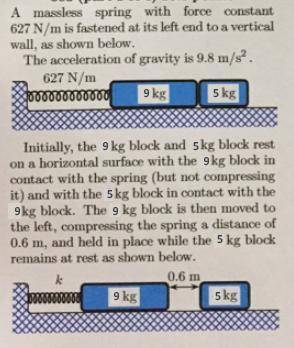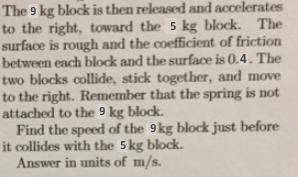
Physics, 07.03.2020 04:59 felipeee4609
The 9 kg block is then released and accelerates to the right, toward the 5 kg block. The surface is rough and the coefficient of friction between each block and the surface is 0.4 . The two blocks collide, stick together, and move to the right. Remember that the spring is not attached to the 9 kg block. Find the speed of the 9 kg block just before it collides with the 5 kg block. Answer in units of m/s

Answers: 2
Another question on Physics

Physics, 22.06.2019 08:30
What object a collides with object b and bounces back its final momentum is?
Answers: 1

Physics, 22.06.2019 18:30
A1000-kg car is moving at 30 m/s around a horizontal unbanked curve whose diameter is 0.20 km. what is the magnitude of the friction force required to keep the car from sliding?
Answers: 3

Physics, 22.06.2019 22:00
1. what is the relationship between wavelength and the penetrating power of an electromagnetic wave? a) the penetrating power has no relationship to the wavelength. b) the penetrating power increases as the wavelength increases. c) the penetrating power decreases as the wavelength increases. d) the penetrating power decreases as the wavelength decreases. 2. as ice melts and turns into water, the speed of sound through the material would most likely do what? justify your answer. a) the speed would not change because the material is always water. b) the speed of sound would increase because the density of water is less than that of ice. c) the speed of sound would increase because energy is added to ice in order to make it melt. d) the speed of sound would decrease because sound travels faster through solids than liquids. 3.which of these waves need a medium to travel through? a) sound b) x-rays c) infrared rays d) visible light
Answers: 3

Physics, 22.06.2019 22:00
The inside surface of a cylindrical-shaped cave of inner diameter 1.0 m is continuously covered with a very thin layer of water. the cave is very long and it is open on both ends. the water on the cave surface is at a constant temperature of 15.5 °c. the cave is constantly exposed to wind such that 15.5 °c air flows through the cave at 4.5 m/s. the kinematic viscosity of the air is 14.66 x 10-6 m2/s and the molecular diffusion coefficient of water vapor in the air is 0.239 x 10-4 m2/s. because the cave diameter is so large, the flow of wind down the length of the cave, in the x direction, can be treated like it is external flow and the cave surface can be approximated as flat where appropriate. calculate the x value, in a) the transition to turbulent flow occurs at rex meters, where the air flow transitions from laminar to turbulent along the inside surface of the cave b) calculate the x value, in meters, where the bulk steady state concentration of water vapor in the air flowing in the cave is 10% of the saturation concentration. assume the air at the surface of the water layer is 100% saturated with water vapor. assume the wind entering the cave contained no moisture before it entered the cave. take into account the transition from laminar to turbulent flow when solving part b
Answers: 1
You know the right answer?
The 9 kg block is then released and accelerates to the right, toward the 5 kg block. The surface is...
Questions

Geography, 30.12.2019 08:31

Biology, 30.12.2019 08:31



Mathematics, 30.12.2019 08:31


History, 30.12.2019 08:31

English, 30.12.2019 08:31

History, 30.12.2019 08:31

History, 30.12.2019 08:31

English, 30.12.2019 08:31



English, 30.12.2019 08:31

Mathematics, 30.12.2019 08:31



Mathematics, 30.12.2019 08:31


Mathematics, 30.12.2019 08:31








 this displacement length of spring = 0.6
this displacement length of spring = 0.6




